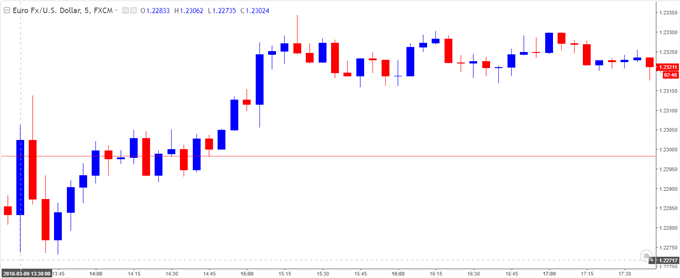TRADING THE NEWS: U.S. NON-FARM PAYROLLS (NFP)

A 185K expansion in U.S. Non-Farm Payrolls (NFP) accompanied by signs of faster wage growth may keep EUR/USD under pressure as it encourages the Federal Open Market Committee (FOMC) to implement higher borrowing costs over the coming months.
A further improvement in labor market dynamics may encourage the FOMC to deliver four rate-hikes for 2018 as ‘the Committee expects that economic conditions will evolve in a manner that will warrant further gradual increases in the federal funds rate,’ and Chairman Jerome Powell and Co. may show a greater willingness to extend the hiking-cycle as the economy nears full employment.
However, a batch of lackluster developments may produce headwinds for the greenback as it drags on interest-rate expectations, with EUR/USD at risk for a rebound as it preserves the March range.
IMPACT THAT THE U.S. NFP REPORT HAS HAD ON EUR/USD DURING THE PREVIOUS PRINT
Period
Data Released
Estimate
Actual
Pips Change
(1 Hour post event )
Pips Change
(End of Day post event)
FEB
2018
03/09/2018 13:30:00 GMT
185K
313K
+17
+20
February 2018 U.S. Non-Farm Payrolls (NFP)
EUR/USD 5-Minute Chart

U.S. Non-Farm Payrolls (NFP) surged 313K in February amid forecasts for a 205K expansion, while the jobless rate held steady at an annualized 4.1% as the Labor Force Participation rate unexpectedly widened to 63.0% from 62.7% in January. A deeper look at the report showed Average Hourly Earnings narrow to an annualized 2.6% from a revised 2.8% in January to mark the first slowdown since October, while Average Weekly Hours bounced back during the same period as the gauged climbed to 34.5 from 34.3 the month prior.














Leave A Comment